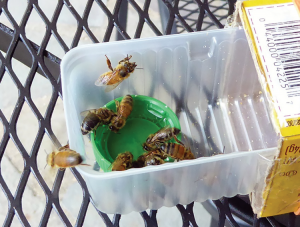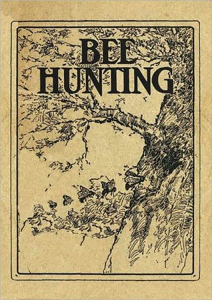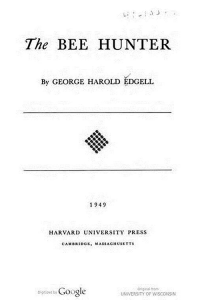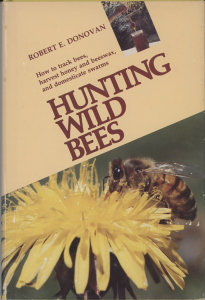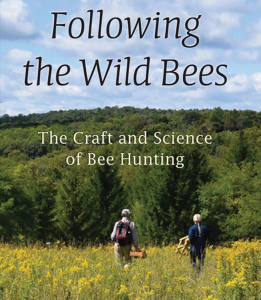By: Frank Linton
A Package Of Cookies, Some Rubber Bands, Sticky Tape And Your Jacknife.
Improvised Bee Lining Box
Can you recall a time when you were stuck at a place you didn’t plan to be, with hours of time on your hands? Perhaps you took a friend to the emergency room and there was a long wait. Whatever the cause, you’re stuck there. What to do?
If you are a beekeeper, you might go outside and look at the blossoms to see what insects are pollinating them. You might see honey bees and wonder “Where are they coming from? Are there beehives nearby or is this a feral colony that is mine for the taking?”
Aha! There’s a question that will take some time to answer, and you have the time. But . . . your trusty bee lining box is at home. What to do?
I suggest you improvise a bee lining box. All you need is a box of Fig Newtons – the 6.5 ounce size, two rubber bands, two bits of tape, and your jackknife.
As you know, a bee lining box has two compartments, an outer one for catching bees, an inner one for holding them; and a door between the compartments.
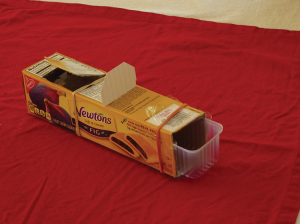
Improvised Bee Lining Box. Showing a Fig Newton box suitably modified by cutting a flap at the left end – with a rubber band for holding the flap closed. A sliding door in the middle divides the box into two compartments. The bee catching tray is shown partially slid open at the right end.
The wrapper that lines the box can be seen under the flap, where it serves as a window, and at the open end of the box where it is attached by a rubber band.
How to make the improvised the bee lining box:
- Open the Fig Newton box at the designated end. Cut off the end flaps and discard them.
- Carefully open the inner cellophane wrapper without tearing it. Remove it from the box.
- Slide out the plastic tray containing the Fig Newtons and dispose of them. Yum.
- Cut a flap on the top of the inner compartment. Use a bit of tape to make a handle for it. Hold the flap closed with one of the rubber bands.
- Roll up a bit of tape – sticky side out. Stick it on the closed end of the cellophane wrapper. Slide the tray into the wrapper and push the tray and wrapper into the box so the wrapper is fastened to the inner end of the box by the tape.
- Carefully cut the wrapper at its four corners where it sticks out of the end of the box. Fold the ends of the wrapper back over the box. Hold the wrapper ends in place with the second rubber band. You may use tape for this, instead. The tray should slide out of the wrapper, while the wrapper lines the box. The wrapper provides a clear view into the tray when the flap is opened. Next, make a door to divide the box into two compartments.
- Find a bit of thin stiff cardboard or plastic to serve as the door. Trim it so that its width is about the same as the Fig Newton box and its length is twice its width.
- Slide the tray out of the box by ¼ inch or so. Trim one end of the door so it fits easily into the tray.
- Cut a slot in the middle of the box. Cut through the wrapper. Do not cut into the tray.
- Slide the door into the slot, ‘tray end’ first. This divides the box, and tray, into two compartments.
Check: With the door closed (inserted into the slot), the tray should easily slide a couple inches in and out of the box.
How to use the improvised bee lining box:
Part 1. Catching bees
- Close the flap and open the door. Slide the tray out a couple inches
- Approach a foraging bee on a blossom, and trap it in the box by quickly putting the tray over the bee and sliding it into the box. Place your hand over the end of the box to darken it.
- Open the flap. The bee will go to the light. Slide in the door to trap the bee in the inner compartment.
- Repeat steps 1 through 3, keeping the door closed except when moving newly caught bees to the inner compartment. Repeat until you have caught a half dozen or more bees.
Part 2. Feeding the bees you caught
- Buy a bottle, not a can, of the sweetest soda in the shop. Fanta Grape is said to be very sweet, as are cream soda, root beer, and Mountain Dew.
- Put some soda in the bottle cap. Put the bottle cap carefully into the outer compartment. Open the door between compartments. Cover the whole thing with a dark piece of cloth (e.g., your jacket). Wait a full five minutes for the bees to fill up on the soda.
- Uncover the box and slide open the tray.
The bees will orient to the box, fly home, and if you are lucky, will bring back their sisters, starting a beeline you can follow to their home. For details on following a beeline, see any of these books:
- Following the Wild Bees by Tom Seeley, 2016.
- The Bee Hunter by George Edgell, 1949.
- Hunting Wild Bees by Robert Donovan, 1980.
- Bee Hunting by John Lockard, 1908.
To conclude, the main point is that you can improvise a bee lining box from materials found in any corner store, and perhaps the items you need are already in your truck, in the trash bag. Use your imagination and make do with whatever you find. Finally, be kind to the bees and switch out that soda for 1:1 sugar syrup.
Frank Linton is an EAS-certified Master Beekeeper. He is the author of The Observation Hive Handbook. Version 2 is now available from the Cornell University Press. Frank hosts the websites http://thebeepeeker.com, a guide to observation hives and http://colonymonitoring.com, a guide to colony monitoring technology.







